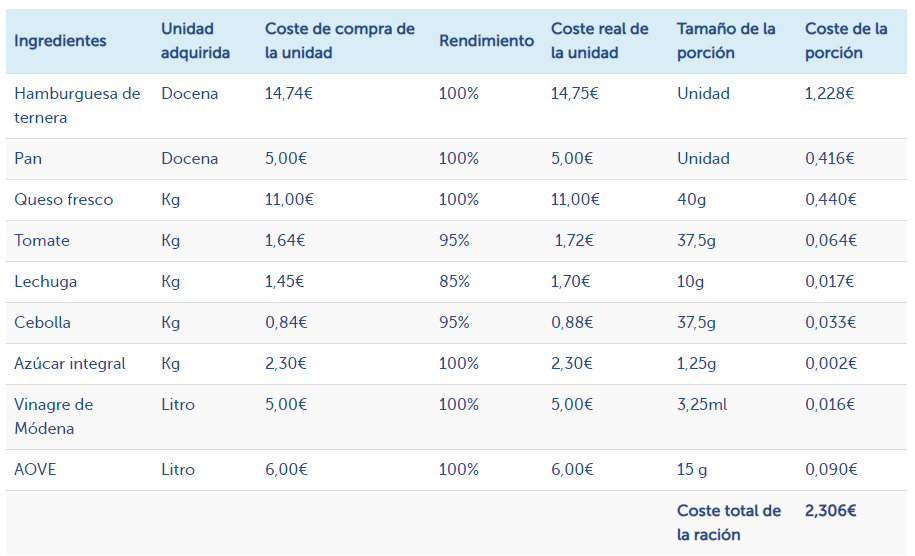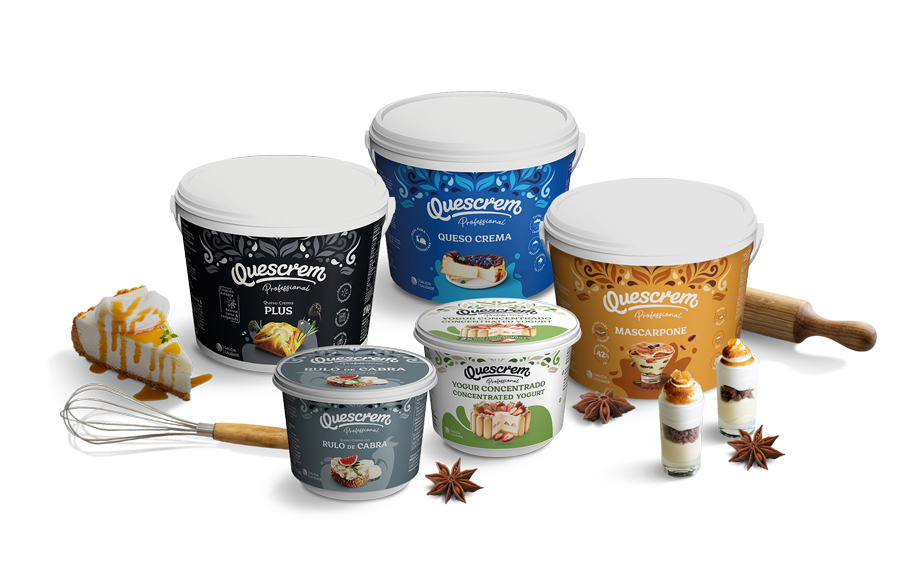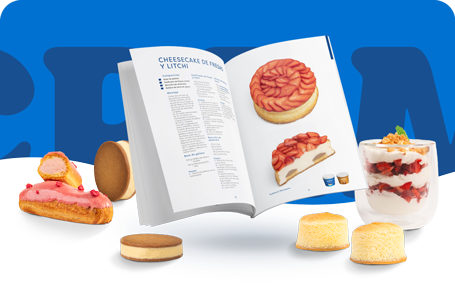If the quality of the dishes and the customer service are essential components of a restaurant’s offer, the calculation of the selling prices of the dishes is a decisive is a decisive factor in the success of a restaurant business.. When are the dishes profitable? How do you strike a balance in order to establish competitive selling prices without damaging your strategic positioning? The price list is a basic tool that can help you. that can help you.
Calculating the price range of a dish is one of the most important practices that any restaurant manager or owner can carry out to achieve these objectives. The cost estimate is a very valuable tool that allows you to allows you to know how much each of the dishes you offer costs and helps you make decisions in key areas, such as total menu pricing and the sales and budget objectives of your business.
 Ingredients: A complete list of the ingredients used to make the dish.
Unit purchased: This is the unit of measure in which the ingredients were purchased from your suppliers. It can be any measurement from grams to kilograms to milliliters or liters, etc.
Unit purchase cost: The price per unit of measure shown on the supplier’s invoice.
Yield: Yield is expressed as a percentage and is the amount remaining after trimming and cleaning. For example, the usable weight after trimming and cleaning a 1,000g piece of meat can be 700g (70% yield).
Actual unit cost: The cost after you have calculated your yield.
Serving size: How much of each ingredient goes into a dish you serve to customers. For example, 250g of meat.
Serving Cost: The cost of the serving size of that ingredient, calculated using the following formula: Serving size x actual unit cost.
Let’s take a look at a typical dish on the menu of many restaurants: a hamburger, in this case a beef cheeseburger.
In this veal cheeseburger recipe we note that the percentage yield of some ingredients, in this case the vegetables, is lower. This data will be of great help to find out the real cost of the unit. To make this calculation, we take the purchase cost of the unit and divide by the % yield.
Ingredients: A complete list of the ingredients used to make the dish.
Unit purchased: This is the unit of measure in which the ingredients were purchased from your suppliers. It can be any measurement from grams to kilograms to milliliters or liters, etc.
Unit purchase cost: The price per unit of measure shown on the supplier’s invoice.
Yield: Yield is expressed as a percentage and is the amount remaining after trimming and cleaning. For example, the usable weight after trimming and cleaning a 1,000g piece of meat can be 700g (70% yield).
Actual unit cost: The cost after you have calculated your yield.
Serving size: How much of each ingredient goes into a dish you serve to customers. For example, 250g of meat.
Serving Cost: The cost of the serving size of that ingredient, calculated using the following formula: Serving size x actual unit cost.
Let’s take a look at a typical dish on the menu of many restaurants: a hamburger, in this case a beef cheeseburger.
In this veal cheeseburger recipe we note that the percentage yield of some ingredients, in this case the vegetables, is lower. This data will be of great help to find out the real cost of the unit. To make this calculation, we take the purchase cost of the unit and divide by the % yield.
 Once we have broken down each of the ingredients and their actual cost, we conclude that our hamburger has a real cost per serving of €2.30.
How to calculate the price of a dish?
The price list is a starting point for calculating the price of a dish. The key to the profitability of a business lies in the calculation of the selling prices of the dishes and menus. And it’s not just a matter of knowing all the costs of the cost estimate, there are also questions of business strategy, positioning, and market acceptance.
Before proceeding with the calculation of your restaurant’s prices, it is important to be clear about some basic notions. Among them, and for the business strategy, it would be advisable to know your total profit margin, i.e. what you have left after having paid all the restaurant’s expenses. The clearest way to calculate this percentage is to divide expenses into three broad categories: food and beverage, labor costs, and venue expenses. The general consensus within the industry tends to distribute these expenses as follows:
Once we have broken down each of the ingredients and their actual cost, we conclude that our hamburger has a real cost per serving of €2.30.
How to calculate the price of a dish?
The price list is a starting point for calculating the price of a dish. The key to the profitability of a business lies in the calculation of the selling prices of the dishes and menus. And it’s not just a matter of knowing all the costs of the cost estimate, there are also questions of business strategy, positioning, and market acceptance.
Before proceeding with the calculation of your restaurant’s prices, it is important to be clear about some basic notions. Among them, and for the business strategy, it would be advisable to know your total profit margin, i.e. what you have left after having paid all the restaurant’s expenses. The clearest way to calculate this percentage is to divide expenses into three broad categories: food and beverage, labor costs, and venue expenses. The general consensus within the industry tends to distribute these expenses as follows:
Advantages of the use of the costing technique
The price list of a dish is a fundamental tool in hotel and kitchen management, with which we control the real cost of each dish per person. It is one of the basic one of the basic strategies to apply menu engineering, with which we will control and optimize with which we will control and optimize spending. Let’s review the main advantages of applying the price list to your restaurant:- The price range of a dish allows you to calculate a fair selling price. By knowing exactly how much a recipe costs, you can make a better decision on the recommended retail price.
- The price range of a dish allows you to find out the margin you get with each of the dishes you offer in your restaurant, being able to make decisions to enhance the dishes with which you get a higher profitability.
- The inventory control facilitates a better control of ingredients and their inventory, thus reducing waste. You will know the exact amounts that each recipe should contain and how much is actually being spent. At the same time, this will allow you to have a better control of your inventory, detecting all kinds of strange shrinkage, possible theft, excessive waste or dishes leaving the kitchen with different portions, etc.
- The order scales help your kitchen team to save time and gain in organizational efficiency . This technique helps to standardize work processes and homogenize portions by knowing the exact quantities of each dish. It will also allow for faster integration of new staff into your business by having clear instructions from day one. In this way you will achieve that the dishes leave the kitchen equal in quantity, cooking and flavor with very positive consequences in the loyalty of your clientele.
- The price list will allow you to make menu changes more easily and frequently. By managing in detail the cost information of certain products, you will see that many seasonal products are usually cheaper and this will allow you to incorporate seasonal products to your menu with greater agility.
- The price list will allow you to to choose the right suppliers for your restaurant . The detailed analysis of the cost of each dish of your menu will allow you to select the suppliers of raw materials with the best performance and the best quality/price ratio.
- Finally, the scandale of a dish will help you to focus the marketing strategy of your business . You will know which recipes to give more prominence to in social networks, website, media advertising, etc.
How is a cost estimate made?
The cost estimate of a dish in practice consists of a card or template in which we will control the costs of a dish or a drink. Although there is no single way to do it, the truth is that the escandallo is more than a detailed cooking recipe as it may seem at first glance. In a price list file we will not only include information about the ingredients and products that make up a dish and the quantities necessary for its preparation, but also its purchase price and the wastage or yield of each of these ingredients, in order to calculate the real final cost of the dish and to know our profit margin. The scandallo can be made in excel, but to help you to make a scandallo in an easier way there are accounting software for the hotel business, even free, that will allow you to computerize this management and make your work easier. In any case, you should keep in mind that:-
Not all of your restaurant’s costs are allocated in the price list of a dish.
-
The basic equation for calculating the cost of the dish or cost estimate
 Ingredients: A complete list of the ingredients used to make the dish.
Unit purchased: This is the unit of measure in which the ingredients were purchased from your suppliers. It can be any measurement from grams to kilograms to milliliters or liters, etc.
Unit purchase cost: The price per unit of measure shown on the supplier’s invoice.
Yield: Yield is expressed as a percentage and is the amount remaining after trimming and cleaning. For example, the usable weight after trimming and cleaning a 1,000g piece of meat can be 700g (70% yield).
Actual unit cost: The cost after you have calculated your yield.
Serving size: How much of each ingredient goes into a dish you serve to customers. For example, 250g of meat.
Serving Cost: The cost of the serving size of that ingredient, calculated using the following formula: Serving size x actual unit cost.
Let’s take a look at a typical dish on the menu of many restaurants: a hamburger, in this case a beef cheeseburger.
In this veal cheeseburger recipe we note that the percentage yield of some ingredients, in this case the vegetables, is lower. This data will be of great help to find out the real cost of the unit. To make this calculation, we take the purchase cost of the unit and divide by the % yield.
Ingredients: A complete list of the ingredients used to make the dish.
Unit purchased: This is the unit of measure in which the ingredients were purchased from your suppliers. It can be any measurement from grams to kilograms to milliliters or liters, etc.
Unit purchase cost: The price per unit of measure shown on the supplier’s invoice.
Yield: Yield is expressed as a percentage and is the amount remaining after trimming and cleaning. For example, the usable weight after trimming and cleaning a 1,000g piece of meat can be 700g (70% yield).
Actual unit cost: The cost after you have calculated your yield.
Serving size: How much of each ingredient goes into a dish you serve to customers. For example, 250g of meat.
Serving Cost: The cost of the serving size of that ingredient, calculated using the following formula: Serving size x actual unit cost.
Let’s take a look at a typical dish on the menu of many restaurants: a hamburger, in this case a beef cheeseburger.
In this veal cheeseburger recipe we note that the percentage yield of some ingredients, in this case the vegetables, is lower. This data will be of great help to find out the real cost of the unit. To make this calculation, we take the purchase cost of the unit and divide by the % yield.
 Once we have broken down each of the ingredients and their actual cost, we conclude that our hamburger has a real cost per serving of €2.30.
How to calculate the price of a dish?
The price list is a starting point for calculating the price of a dish. The key to the profitability of a business lies in the calculation of the selling prices of the dishes and menus. And it’s not just a matter of knowing all the costs of the cost estimate, there are also questions of business strategy, positioning, and market acceptance.
Before proceeding with the calculation of your restaurant’s prices, it is important to be clear about some basic notions. Among them, and for the business strategy, it would be advisable to know your total profit margin, i.e. what you have left after having paid all the restaurant’s expenses. The clearest way to calculate this percentage is to divide expenses into three broad categories: food and beverage, labor costs, and venue expenses. The general consensus within the industry tends to distribute these expenses as follows:
Once we have broken down each of the ingredients and their actual cost, we conclude that our hamburger has a real cost per serving of €2.30.
How to calculate the price of a dish?
The price list is a starting point for calculating the price of a dish. The key to the profitability of a business lies in the calculation of the selling prices of the dishes and menus. And it’s not just a matter of knowing all the costs of the cost estimate, there are also questions of business strategy, positioning, and market acceptance.
Before proceeding with the calculation of your restaurant’s prices, it is important to be clear about some basic notions. Among them, and for the business strategy, it would be advisable to know your total profit margin, i.e. what you have left after having paid all the restaurant’s expenses. The clearest way to calculate this percentage is to divide expenses into three broad categories: food and beverage, labor costs, and venue expenses. The general consensus within the industry tends to distribute these expenses as follows:
- Food and beverage costs: about 30% but never more than 35%.
- Labor costs: about 35%.
- Occupancy costs: which include insurance, taxes and permits, in addition to mortgage or rent, energy supply and cleaning of the premises, which should be around 20%.
Calculation of the final selling price
Starting from the price range of the dish, there are many methods to establish the prices of a menu. Many of these pricing methods are based only on subjective criteria and are inadequate and inefficient, as they do not focus on real information about the products and their actual costs. In general, these are methods that belong to a time when computerized tools were conspicuous by their absence and were based more on comparison with the competition or the establishment of what were considered reasonable prices for customers. A method of calculating the selling price must always be based on objective criteria as a result of an exhaustive analysis of all the expenses we are going to incur in our activity, the gross profit margin we want to achieve, and the market study we have done. The prices we set should be aligned with the quality of the experience we are offering to the diner, and with the average spending level that our target audience considers appropriate for our value proposition, according to our positioning, our location, etc. They must be attractive prices for the consumer and profitable for your business. There are different objective criteria applicable, and although none of them is a 100% infallible method, we can approach the maximum possible profitability. These are some of the main ones:Overpricing methods
They are based on adding a surcharge to the cost of the product, without taking into account other variables such as labor costs or shrinkage. It is not a 100% reliable method as it overlooks something important for your valuation, which is what your customers are willing to pay for the dishes you offer and the experience they will have at your place. This method has several application modalities:- Method of pricing ingredients through surcharging. It considers all food and beverage costs and is based on 3 steps:
- Determine ingredient costs.
- Determine the multiplying factor to be used to fix the increase or surcharge of ingredient costs. This factor is usually set as standard at 40% but can also be set based on the planned or desired percentage.
- Establish a base selling price by multiplying the ingredient costs by the multiplier factor.
- Overpricing or mark-up pricing method for the primary ingredient. Similar to the previous method but here the multiplying factor is only calculated on the primary ingredient and multiplied by the remaining ingredient cost.
- Pricing method using overpricing with ancillary costs. The cost of standard side dishes (salads, side dishes) is added to the main dishes or other primary ingredients. This sum is multiplied by the multiplier factor for overpricing, as in the previous method.
Marginal contribution method
The contribution margin in this method is the difference between the selling price of the dish minus the variable costs. This contribution margin should cover fixed costs and expected profit.-
- Fixed costs: Costs that remain constant regardless of whether more or less is produced.
- Variable costs: They change according to the volume of production.
- Profit: It corresponds to the percentage of the invested cost (fixed cost + variable cost) to be earned. Example: if the total cost of a dish in a menu is 20€ and the restaurateur wants to earn 20% on that cost, he must sell the dish at 24€. Your profit will then be €4.
Primary cost method
The term primary costs refers to the most important costs in food, beverages, and labor. This method involves evaluating labor costs based on the expected number of customers. As in other cost analyses, there are different formulas and methods to obtain the value at which we should offer our dishes for sale.4.Percentage of profit over food costmethod
It is perhaps one of the most widely used methods and is estimated on the real cost price of our dishes that we have previously made by means of an estimate, calculating a profit percentage between 30-35%. This percentage would include the costs of wastage, since there will always be some waste during cooking that must be taken into account; and the rest of the costs of our business, whether fixed or variable (rent, labor costs, energy costs, etc.). The calculation exercise to be carried out would consist of dividing the cost of a dish by this percentage, thus obtaining the price of each of the dishes on the menu. If you pay €1 for something, you must charge a minimum of €3.35 at the time of sale. It may seem like you’re charging way more than you need to, but remember that you’re not just paying for the food itself. You pay someone to prepare it, serve it and clean it up afterwards. You also need enough gross profit to pay for the building your customers are eating in and take care of the other costs to keep your business afloat. Being one of the most widely used methods, we are going to apply it to our initial example of a beef cheeseburger recipe and the results we obtained with its scandallo: Actual cost of a beef hamburger: 2,30€. Percentage increase: 35%. 2,30 / 0,35 = 6,57€ This price may not seem commercial to us and we prefer to set it at €6.50. Your gross profit margin on this menu item would still be in the 30-35% range, but the price is more attractive. This is what we call price psychology.-
Prices change as changes are made to the recipe
-
The importance of portion control
-
A well-balanced menu in terms of price
The pricing policy of a restaurant, as in any other business, has an important impact on its medium-term success or failure. Striking a balance between covering expenses incurred and seeking a reasonable profit, without sacrificing the desired quality, will help you attract and retain your target clientele. To do this, it is essential to know how to make the price of a dish and calculate the selling price .



